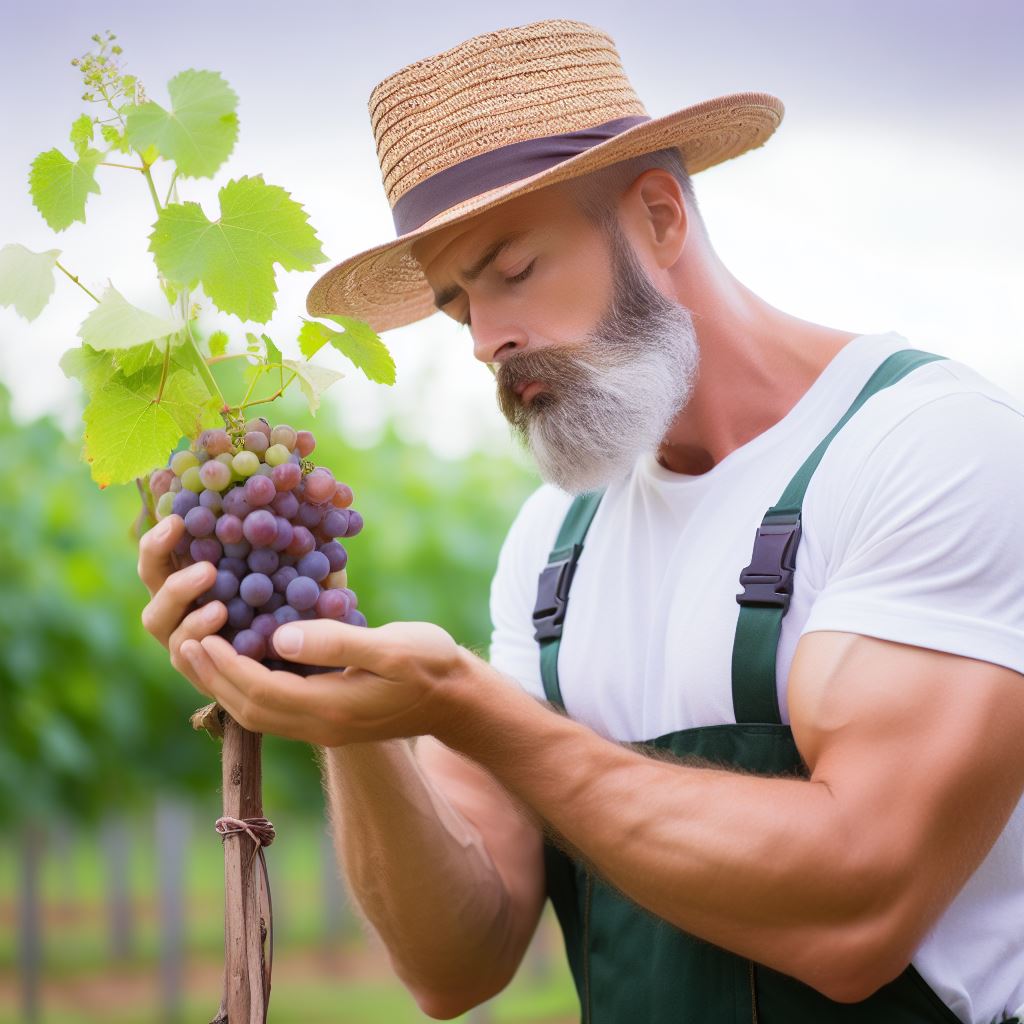Grape Expectations: A Vintner Journey
Last Updated on November 24, 2023
Introduction
Understanding a vintner’s journey is important as it provides insights into the complex world of winemaking.
This blog post aims to shed light on the challenges and triumphs that vintners face in creating exquisite wines.
As wine enthusiasts, it is crucial for us to comprehend the intricate process and immense dedication required to produce a bottle of wine.
A vintner’s journey encompasses everything from selecting the right grapes to mastering the art of fermentation and aging.
By delving into a vintner’s journey, we can appreciate the meticulous craftsmanship and artistry involved in winemaking.
This understanding allows us to have a deeper connection with the final product, allowing us to fully savor the flavors and aromas.
Moreover, learning about a vintner’s journey allows us to support and value the efforts of the winemakers.
By understanding their challenges and dedication, we can support local wineries and help sustain the rich tradition of winemaking.
This blog post will take you on a captivating journey, exploring the passion and commitment vintners pour into their craft.
Through stories and experiences, we will gain valuable insights into the world of winemaking, from vineyards to cellars.
Join us as we embark on this adventure, gaining a newfound appreciation for the journey that each bottle of wine undertakes before reaching our lips.
This knowledge will enhance our enjoyment of wine, making every sip a moment to be cherished.
The Vintner’s Journey Begins
As I embarked on my vintner’s journey, I delved into the fascinating world of grape cultivation.
Grape cultivation is an ancient practice that requires immense dedication and knowledge.
Understanding the background of grape cultivation provided me with a solid foundation for my winemaking endeavors.
Background information on grape cultivation
From selecting the right vineyard site to nurturing the grapevines, every step in grape cultivation plays a crucial role.
The soil, climate, and sunlight conditions of the vineyard greatly impact the growth and quality of grapes.
Grafting, cuttings, or seeds are used for grapevine propagation, ensuring the continuity of desirable grape varieties.
Overview of the steps involved in winemaking
Winemaking, the next phase of my journey, is an intricate process that transforms grapes into wine.
Harvesting the grapes at optimal ripeness is of utmost importance.
Sorting and crushing the grapes gently releases their juice, which is the building block of wine.
The fermentation process, where yeast converts sugars into alcohol, is a critical step that imparts desired flavors and characteristics to the wine.
Importance of grape quality for producing exceptional wines
The quality of grapes is fundamental in producing exceptional wines.
The balance of sugars, acids, and tannins is essential for a well-rounded wine.
Different grape varieties, grown in specific climates and soil types, offer unique characteristics, allowing vintners to craft a wide variety of wines.
Meticulous vineyard management and careful grape selection contribute to the production of wines that truly stand out.
As a vintner passionate about producing exceptional wines, I continually strive to improve grape quality.
Techniques like canopy management and irrigation aid in optimizing grape development.
By focusing on grape quality at every stage, I can ensure that my wines reflect the unique qualities and characteristics of the grapes themselves.
With a solid understanding of grape cultivation and winemaking, I was prepared to embark on my journey as a vintner.
The next sections of my story would reveal the challenges, triumphs, and discoveries that awaited me on the path to creating memorable wines.
Vintner’s Trials and Tribulations
Challenges faced by vintners in grape cultivation
- Choosing the right grape varieties for the specific climate and soil conditions.
- Navigating the complexities of planting, pruning, and training grapevines to maximize yield and grape quality.
- Managing irrigation systems to ensure adequate water supply without waterlogging the grape roots.
- Battling against weed competition which can hinder grapevine growth and steal essential nutrients.
- Protecting grapevines from animal damages, such as deer or birds, through effective deterrent strategies.
- Maintaining proper canopy management to optimize sunlight exposure and airflow within the grapevine rows.
- Preventing soil erosion and managing soil fertility to create a healthy environment for grape cultivation.
- Ensuring proper grape ripening by monitoring sugar levels, acidity, and tannin development throughout the growing season.
- Harvesting grapes at the optimal time to achieve the desired flavor profile and balance between acidity and sweetness.
- Overcoming labor constraints in vineyard management, such as finding skilled workers for manual grape picking and pruning tasks.
Impact of weather conditions on grape quality
- Inconsistent rainfall patterns can affect grapevine growth, leading to smaller yields and lower grape quality.
- Extreme temperatures, both hot and cold, can stress grapevines and affect the ripening process.
- Hailstorms can cause severe damage to grape clusters, resulting in reduced yield and overall grape quality.
- Frost events during bud break can destroy young grapevine shoots, delaying or preventing the growth of the grape crop.
- High humidity levels can increase the risk of fungal diseases, affecting grape health and reducing their quality.
- Excessive rainfall close to harvest can dilute grape flavors and increase the vulnerability to rot and fungal infections.
- Extended drought periods can lead to water stress, affecting grapevine health and impacting the quality of the grapes.
- Unpredictable weather conditions pose challenges in planning and executing vineyard operations effectively.
- Climate change may alter traditional grape-growing regions as vintners need to adapt to new temperature and precipitation patterns.
- Adopting weather monitoring technologies and implementing climate-smart vineyard practices can mitigate weather-related risks.
Dealing with common grape diseases and pests
- Powdery mildew is a fungal disease that affects grapevines, reducing grape quality and yield.
- Downy mildew, caused by another fungus, can infect grape leaves and clusters, resulting in rot and compromise taste.
- Botrytis cinerea, commonly known as gray mold, can ruin grape clusters, leading to significant economic losses.
- Phylloxera, a tiny aphid-like insect, attacks grapevine roots, causing them to wither and eventually killing the vines.
- Grapevine leafroll disease impacts vine health, reducing grape ripeness, and compromising wine quality.
- Black rot, caused by a fungus, can infect grape berries, leading to shriveled, mummified grapes.
- Grapes are also a target for birds, causing damage to the crop, and requiring bird netting or scare tactics for protection.
- Pesticide application and integrated pest management strategies are employed to combat pests and diseases sustainably.
- Regular scouting and monitoring of vineyards help detect early signs of diseases and pests for timely intervention.
- Implementing cultural practices like pruning techniques and canopy management can reduce disease pressure and improve air circulation.
In the journey of a vintner, mastering the art of grape cultivation involves overcoming numerous challenges.
From selecting the right grape varieties and managing irrigation systems to protecting against animals and fighting diseases, vintners face an array of obstacles.
Weather conditions also play a significant role in grape quality, and extremes in temperature, rainfall, and humidity can impact the vines’ health and grape development.
Furthermore, grape diseases and pests pose additional threats, requiring careful monitoring and the implementation of preventive measures.
Despite the trials and tribulations, passionate vintners rely on experience, knowledge, and innovative techniques to navigate these hurdles, ultimately producing exceptional grapes for the creation of exquisite wines.
Read: Biofuel Policies: Effects on Crop Choices
Nurturing the Grapes: Vintner’s Techniques
Vineyard management practices
Nurturing the grapes is an essential aspect of a vintner’s journey towards producing high-quality wines.
Proper vineyard management practices are crucial for ensuring the health and productivity of the grapevines.
This involves implementing effective pest control measures, monitoring weather conditions, and regularly inspecting the vineyard for signs of disease or damage.
Soil preparation and maintenance
Soil preparation and maintenance are also vital for grape growth.
Conducting soil analysis helps vintners understand the soil’s composition and nutrient content.
By amending the soil with organic matter and regularly tilling it, they can improve its fertility and drainage.
Implementing erosion control measures and monitoring soil moisture levels are also necessary to maintain optimal growing conditions.
Pruning and trellising techniques for optimum grape growth
Pruning and trellising techniques play a significant role in grapevine management.
In this context pruning the vines during the dormant season allows vintners to remove unwanted or diseased wood, promoting healthy growth.
Training the vines along a trellis system ensures better sunlight exposure and air circulation.
This, combined with appropriate pruning techniques, helps control vine vigor and yield.
Regular inspection of trellis wires and supports, as well as implementing canopy management practices, further optimize grape ripening and disease prevention.
Irrigation and fertilization methods
Irrigation and fertilization methods are essential for supplying the grapevines with sufficient water and nutrients.
Monitoring soil moisture levels enables vintners to provide the right amount of irrigation when necessary.
Drip irrigation systems are commonly used as they deliver water directly to the root zone, reducing water wastage.
When applying fertilizers, vintners take into account soil analysis and plant nutrient requirements.
Organic fertilizers are often preferred to promote soil health and minimize environmental impact.
Regular monitoring of plant nutrient levels helps prevent deficiencies or excesses, ensuring the vines thrive.
To summarize, nurturing the grapes through vineyard management practices, proper soil preparation and maintenance, pruning and trellising techniques, and appropriate irrigation and fertilization methods are vital for a vintner’s success.
These techniques enable them to cultivate healthy grapevines and produce grapes of exceptional quality, ultimately contributing to the production of outstanding wines.
Read: Harvest Tales: Life in the Wheat Fields
Harvesting the Fruits of Labor
Harvesting the fruits of labor is a critical step in the winemaking process.
When it comes to the grape harvest, timing is everything.
Vintners must carefully determine the right time to pick the grapes to ensure optimal flavor and quality in the final wine.
Determining the right time for grape harvest
Determining the right time for grape harvest involves a combination of scientific analysis and sensory evaluation.
Vintners monitor sugar levels, acidity, and flavor development to determine when the grapes have reached peak ripeness.
Regular taste tests and visual inspections are conducted to assess the grape’s color, skin texture, and seed maturity.
Weather conditions also play a crucial role, as they can affect flavor development and grape quality.
Collaboration between vintners, viticulturists, and winemakers is essential in determining the ideal harvest time for each grape variety.
Through their expertise and experience, they can make informed decisions that will result in the best possible grapes for winemaking.
Grape picking and sorting procedures
Grape picking and sorting procedures are carried out with utmost care to ensure only the highest quality grapes are harvested.
Vintners provide workers with the necessary tools and instructions to efficiently pick grapes that meet quality standards.
Damaged or unripe grapes are discarded during the picking process. It is crucial to handle the grapes gently during picking to prevent bruising or damage.
After picking, the grapes are immediately sorted to remove any impurities.
Leaves, stems, and other undesirable elements are carefully separated from the grapes.
Sorting tables or machines are used to quicken the process and ensure accuracy in separating the grapes based on size and quality.
Post-harvest handling and transportation of grapes
Post-harvest handling and transportation of the grapes play a significant role in maintaining their quality. Proper storage in clean containers or bins is crucial to prevent crushing or bruising.
Temperature-controlled environments are necessary to delay fermentation and maintain grape freshness.
Transporting the grapes quickly to the winery or processing facility is essential to avoid deterioration or spoilage.
Refrigerated trucks or insulated containers are used to protect the grapes from extreme temperatures during transportation.
Sealing the containers tightly minimizes exposure to oxygen, preserving grape quality and preventing oxidation.
In general, harvesting grapes is a crucial step in winemaking that requires precise timing and careful handling.
Vintners must determine the right time for harvest, carry out efficient picking and sorting procedures, and ensure proper post-harvest handling and transportation.
By paying attention to these details, vintners can truly enjoy the fruits of their labor in crafting exceptional wines.
Read: Dawn to Dusk: A Dairy Farmer Story

From Grapes to Wine: The Art of Winemaking
Grape Crushing and Pressing
- Grapes are carefully harvested and sorted to ensure only the best fruit is used.
- The grapes are then crushed to release the juice and break down the skins.
- After crushing, the grapes are pressed to extract as much juice as possible.
- This process helps to separate the juice from the solids, such as stems and seeds.
Fermentation and Maturation Processes
- The extracted grape juice is then transferred to fermentation vessels, which can be stainless steel tanks or oak barrels.
- Yeast is added to the juice, which converts the sugars into alcohol through a process called fermentation.
- During fermentation, the yeast consumes the sugars and produces carbon dioxide and alcohol as byproducts.
- The temperature and time of fermentation are carefully controlled to achieve the desired flavors and aromas.
- After fermentation, the wine is left to mature in oak barrels or stainless steel tanks, depending on the winemaker’s preference.
Role of Barrels in Aging and Flavor Development
- Barrels play a crucial role in the aging and flavor development of wine.
- Oak barrels are commonly used due to their ability to impart distinct flavors and textures to the wine.
- During the aging process, the wine slowly undergoes chemical reactions with the wood, adding complexity and depth.
- The porous nature of oak allows for a micro-oxygenation process, which aids in the wine’s development.
- The type of oak used and the level of toasting applied to the barrels can greatly influence the wine’s character.
- Some winemakers choose to age their wines in stainless steel tanks to preserve the freshness and fruity characteristics.
In a nutshell, the art of winemaking involves several crucial steps, from grape crushing and pressing to fermentation and maturation processes.
Each step contributes to the development of unique flavors and aromas in the final product.
Whether aged in oak barrels or stainless steel tanks, winemakers carefully craft their wines to achieve the desired characteristics that wine enthusiasts enjoy.
Read: Hops and Dreams: The Craft Beer Farmer
The Journey Continues: Bottling and Marketing
Bottling and packaging procedures
- The vintner carefully selects bottles, corks, and labels to ensure the finest quality presentation.
- The wine is filtered and transferred into bottles through a specialized machine.
- Each bottle is sealed with a cork, ensuring the freshness and longevity of the wine.
- The bottles are labeled and packaged, ready to be shipped to distributors and customers.
Labeling and regulatory requirements
- The vintner must adhere to specific labeling regulations set by the wine industry and government agencies.
- Labels must include information such as the wine’s origin, alcohol content, and allergen warnings.
- The vintner ensures that all labeling is accurate and meets legal requirements before bottling the wine.
- Compliance with regulatory requirements is essential to avoid legal issues and maintain consumer trust.
Strategies for marketing and promoting wines
- The vintner develops a comprehensive marketing plan to create brand awareness and increase sales.
- Effective strategies include participating in wine festivals, tastings, and industry events for exposure.
- The vintner leverages social media platforms to engage with customers and promote their wines.
- Collaborating with local restaurants and wine shops for tastings and featured placements can boost visibility.
- Positive customer reviews and testimonials play a crucial role in generating word-of-mouth marketing.
- Implementing a loyalty program or offering exclusive discounts creates incentives for repeat customers.
- Creating visually appealing packaging and offering limited-edition releases can pique consumer interest.
- Online platforms, such as e-commerce websites, provide accessibility and reach to a broader customer base.
- The vintner may also consider partnering with influencers and wine experts to endorse and review their products.
- Engaging in public relations activities, like press releases and media outreach, can build credibility and trust.
In the competitive wine industry, the bottling process, labeling regulations, and marketing strategies are essential for success.
By focusing on quality packaging, meeting regulatory requirements, and implementing effective marketing tactics, vintners can increase brand recognition and ultimately drive sales.
It is a continuous journey of refining techniques, staying compliant, and engaging with customers to create a thriving wine business.
Vintner’s Rewards and Successes
Tasting and evaluating the final product
- The culmination of a vintner’s journey is the moment when they get to taste and evaluate the final product.
- They carefully analyze the aroma, flavor, and texture of the wine, assessing its quality and potential.
- This moment is both exciting and nerve-wracking, as vintners have invested time, effort, and passion into their creation.
- They savor each sip, taking note of any nuances or imperfections that may require adjustments for future batches.
- Ultimately, tasting and evaluating the final product provides vintners with a sense of satisfaction and accomplishment.
Recognition and awards received by vintners
- Vintners who produce exceptional wines often receive recognition and awards for their craftsmanship and dedication.
- These accolades can come from prestigious wine competitions, critics, or industry peers.
- Winning awards not only validates a vintner’s skills but also boosts their reputation and marketability.
- The recognition can lead to increased sales and distribution opportunities, expanding their reach to a wider audience.
- Receiving awards is a testament to a vintner’s commitment and expertise, motivating them to continue innovating and improving.
Achieving customer satisfaction
- One of the greatest rewards for vintners is the satisfaction they derive from their customers’ enjoyment of their wines.
- When customers appreciate and cherish their creations, it is a validation of their hard work and craftsmanship.
- Positive feedback from consumers can be incredibly fulfilling, as it demonstrates the vintner’s ability to create wines that resonate with people’s tastes.
- Word-of-mouth recommendations and repeat purchases from satisfied customers are crucial for a vintner’s success and growth.
- Achieving customer satisfaction not only rewards vintners emotionally but also financially, as it drives sales and builds brand loyalty.
In review, the rewards and successes of vintners encompass tasting and evaluating the final product, receiving recognition and awards, and achieving customer satisfaction.
The journey of a vintner is incomplete without these milestones, which fuel their passion, validate their skills, and drive their desire to create exceptional wines.
Conclusion
In this blog section, we have followed the vintner’s journey, from vine to bottle.
In the vineyards’ embrace, our vintner toiled, coaxing grapes to perfection, a labor of passion and dedication.
Crafting a fine bottle of wine entails meticulous vine care, precise fermentation, and the artful dance of blending.
The vintner’s journey isn’t just a process; it’s a symphony of commitment, skill, and a deep respect for the land.
It is important to understand the immense efforts and dedication that go into producing a fine bottle of wine.
Grasping the intricacies behind each pour transforms a casual sip into an appreciation of craftsmanship and legacy.
To fully savor a glass, pause to acknowledge the vintner’s craft. Taste the stories woven into every drop.
As the curtain falls, embrace the vintner’s journey, for within each bottle lies a chapter of dedication and dreams.
Cheers to understanding and appreciating the journey behind every grape’s transformation.
I hope this journey has shed light on the vintner’s craft and encourages readers to appreciate the beauty of it.


